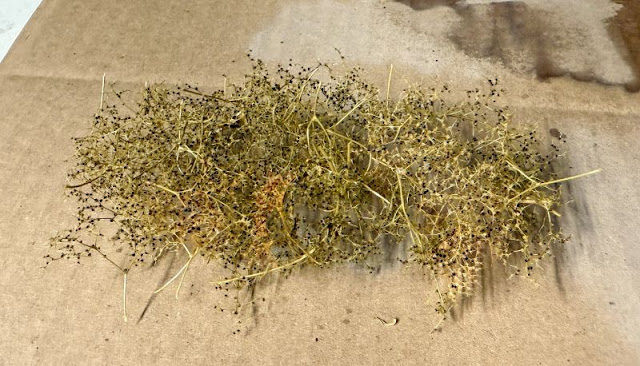When I first contemplated building my bog, I wondered what I should use for the water?
When I watched the video by Grant Eastman when he made his bog on his N scale SAR layout, he used Woodland Scenics Realistic Water with good results. So I thought why not? It's easier than a 2 part epoxy. In fact I had used it on my Whitewater Creek about a year ago and had good results with it.
After doing some research, he found out why?
The realistic water does NOT dry solidly and you are not suppose to pour it over non-acrylic paint or PVA glues like Elmer's. I did notice that in my Whitewater Creek a few months later, there were some tiny bubbles forming around the reeds that I glued in place using Mod Podge. But they are not as bad as what he encountered. His were LARGE.
So now I had two things to think about before pouring the water in the bog.
1) What should I use for the water?
2) What should I use to glue my dead trees to the bog floor?
Well for the water, I remembered watching Boomer when he made his river scene and a drainage ditch. Both turned out very nice. He uses a lot of artist supplies for his modeling. For his river, he used a mix of Golden soft gel semi-gloss mixed GAC 500 (it's very glossy when dried). The soft gel was thick so it would hold its shape for ripples, but he mixed GAC 500 to thin it just a bit, then spread it out and used a sponge with a dabbing motion to create the ripples. Another thing about GAC 500, it doesn't creep like most resins tend to do.
For the drainage ditch, he used straight GAC 500 pouring it with several thin layers of no more than 1/4".
Great! This sounds like a winner, I'll give it a try.
Now for gluing the trees to the bog? Not using the WS realistic water, I didn't have to worry about the bubbles. But keeping this in mind, I still didn't want to use a PVA glue, what about acrylic caulking? I tried it but it took too long to dry?
Someone told me to use CA with an accelerant. That would work, but I didn't want to get anything sprayed on the painted bog floor that might react?
Then a friend told me to try some UV Resin glue, it's fast, strong and dries quickly with a shot of UV light. It also dries completely clear. I've used this stuff to add LEDs for my loco heads lights and it works awesome. So with this info and material on hand it was time to do a test.
I grabbed a small plastic lid, glued some sticks and a couple of weed tufts to the bottom with the UV Resin, it was fast and clear! While it's not a permanent glue, it would hold stuff in place until the GAC 500 was poured and dried.
I poured it to about 1/8" and it did self level, but I had to coax into the weeds and up to the trees, no big deal. Then I let it dry. It went down solid white and started to turn clear once it started drying the next day.
After three days, it was still slightly milky in some areas. It's been 6 days now and it's still showing some milkiness. But the good news is, the UV Resin is not releasing any bubbles. It also didn't creep, although it looks like it did because it shrunk thinner.
Wondering how long GAC 500 takes to fully cure, I asked Boomer a question via his YT channel and he replied it could take a bit and that maybe I should try Liquitex gloss pouring medium. He said it was much more forgiving. OK, I'll give it a shot. I went to Amazon and ordered a bottle of it.
First thing I noticed was it was not 100% white in color but actually semi translucent. It was a bit thicker, but not much (and found out you can thin it a bit if needed). It did not creep, and I had to coax it into the weeds and around the trees. I walked away.
Tonight I took a peek and it was dry and 98% clear, with only a very small amount around the edges and in some of the weeds where it was thicker. Cool! The other thing I noticed is that it did shrink just like the GAC 500. But with no ill effects that I could see, it just got thinner.
So I grabbed the Liquitex and made another pour over top, filling it to the rim again and walked away for the night. We'll see how it turns out tomorrow...























